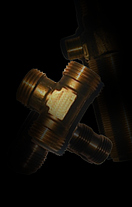5 Ways to Reduce the Cost of Machining Unleaded Brass
 Thanks to tougher state and pending federal regulations, if you machine brass parts that will be used to deliver potable water you are either preparing to or already in the process of machining these parts from no-lead brass. Moreover, it’s expected that in the near future lead will no longer be used in any ferrous or non-ferrous alloys. So CNC machine shops that traditionally work with leaded brass face new challenges as they switch to unleaded material.
Thanks to tougher state and pending federal regulations, if you machine brass parts that will be used to deliver potable water you are either preparing to or already in the process of machining these parts from no-lead brass. Moreover, it’s expected that in the near future lead will no longer be used in any ferrous or non-ferrous alloys. So CNC machine shops that traditionally work with leaded brass face new challenges as they switch to unleaded material.
The reason lead has traditionally been added to brass is that, because of its softness and lubricating properties, it enables CNC machines to operate at higher spindle speeds. Therefore, machining no-lead brass can mean slower speeds and feeds plus higher material and perishable tool costs. All of which can increase cost-per-part by 50% or more. With this in mind, Gosiger applications specialists offer the following suggestions to reduce the cost of machining unleaded brass:
- First and foremost, the CNC machine tools used to cut leaded brass may not have the torque, rigidity or other characteristics necessary to successfully machine unleaded brass, so you may need to modify or refurbish your current equipment, or upgrade to more capable machines. Depending on the nature and volume of parts you produce, it may also make sense to consider multi-function machine tools that can perform several operations in one setup. Gosiger applications engineers can advise you of your best course of action.
- Unleaded brass is harder to cut and generates greater heat. Therefore using the same tooling you were using on leaded brass can be a costly mistake. The type of unleaded brass material being used and the processes being performed dictate the kind of cutting tool material, coatings (such as AITiN and TiN coated carbide) and point style to be used. Certain applications may also require higher helix angles, increased clearance angles and wider flutes. ISO insert style tools become the standard, as the brazed carbide step tool is no longer practical.
- Increased friction-produced heat requires precise applications of coolant to the cutting area. Higher coolant pressure directed at the cut can also break up chips to help maintain surface finish and aid in chip disposal. In many cases this requires high-pressure coolant delivered at 40 to 75 bar. Programmable, high-pressure coolant systems that provide variable pressures are helpful when switching between various types of materials.
- If you need to reduce cutting speeds to compensate for the increased heat build-up when machining unleaded brass, you can increase the feed rate to maintain a removal rate that helps make up for the speed reduction.
- One approach to dealing with the impact on productivity when switching to unleaded brass is to machine hot forged parts rather than working from bar stock. These parts are near net shape, machine more easily than bar stock and require less material removal. Hot forging technology that produces cored forgings also provides further weight reduction.
There’s more to know about making the change to machining unleaded brass, and with over 90 years of metalworking manufacturing experience behind it, the Gosiger team is ready to help.
 |